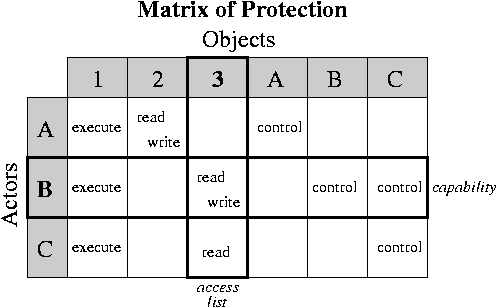CS 537 Notes, Section #29: Protection and Security
The purpose of a
protection system is to prevent accidental or
intentional misuse of a system.
-
Accidents:
Problems of this kind are easy to solve (can do things to make
the likelihood small).
-
Malicious abuse:
Problems of this kind are very
hard to completely eliminate (cannot leave any loopholes,
cannot play on probabilities).
There are three aspects to a protection mechanism:
-
User identification (authentication): make sure we know who is doing what.
-
Authorization determination: must figure out what the user
is and is not allowed to do. Need a simple database for this.
-
Access enforcement: must make sure there are no loopholes
in the system.
Even the slightest flaw in any of these areas may ruin the whole
protection mechanism.
Authentication
Modern authentication is based on a
three factor model:
(1) what you have,
(2) what you are, and
(3) what you know.
What you know:
This means some sort of
password
or
PIN
number.
Passwords are commonly used by themselves and so are a relatively week
form of authentication.
-
Passwords should not be stored in a readable form.
One-way transformations should be used.
-
Passwords should be relatively long and obscure.
Paradox:
short passwords are easy to guess or crack; long passwords are easily
forgotten and usually written down.
What you have:
This means some sort physical device that you hold.
It should be something that is difficult for forge or copy and,
if stolen, is hard to use.
Some examples:
-
A physical key: often easy to copy, and easy to use if stolen.
-
An identification badge: moderate to difficult to copy and easy to use if
stolen.
-
Crypto card or app:
generates one-time use keys. Difficult (not impossible) to copy of the
chips are designed to be tamper resistant.
The addition of a PIN number for the device makes it hard to use if stolen (this
is effectively adding a second factor).
What you are:
this means using physical data about your body, called
biometrics.
It might be a finger or hand print, retinal scan, facial recognition, or even
weight (or some combination of these).
-
Fingerprint readers are now common, found on lots of smart phones and
laptop computers.
Finger or hand print readers are common in secure environments.
For example, U.S. Customs and Border Protection uses finger prints
for both frequent travelers (the Global Entry system) and foreign visitors.
-
CERN uses retinal scans to restrict access to their
underground accelerator beam tunnel.
-
Some secure environments will weigh you as you enter or exit to see if
that is consistent with your records.
(Lots of false alarms after the holidays!)
You use two or three factor authentication for stronger security.
Just using one factor alone has significant weakness.
The most secure environments use all three factors, which means that the
tricks that you have seen in the James Bond movies would not work that
well in the real world.
Once identification is complete, the system must be sure to protect
the identity since other parts of the system will rely on it.
Authorization Determination
Must indicate who is allowed to do
what with what. Draw the general form as an access matrix with one row
per user, one column per file. Each entry indicates the
privileges of that user on that object. There are two general ways of
storing this information: access lists and capabilities.
Access Lists: with each file, indicate which users are allowed
to perform which operations.
-
In the most general form, each file has a list
of pairs.
-
It would be tedious to have a separate
listing for every user, so they are usually grouped into classes.
For example, in Unix there are three classes: self, group, anybody
else (nine bits per file).
-
Access lists are simple, and are used in almost all file systems.
Capabilities: with each user, indicate which files may be accessed,
and in what ways.
-
Store a list of pairs with each user.
This is called a capability list.
-
Typically, capability systems use a different naming
arrangement, where the capabilities are the only names
of objects. You cannot even name objects not referred to in
your capability list.
-
In access-list systems, the default is usually for everyone
to be able to access a file. In capability-based systems, the
default is for no-one to be able to access a file unless they
have been given a capability. There is no way of even naming
an object without a capability.
-
Capabilities are usually used in systems that need to be very secure.
However, capabilities can make it difficult to share information:
nobody can get access to your stuff unless you explicitly give
it to them.

Are the following things access-based or capability-based
protection schemes?
-
Protection Keys
-
Page tables
Access Enforcement
Some part of the system must be responsible
for enforcing access controls and protecting the authorization and
identification information.
-
Obviously, this portion of the system must run unprotected.
Thus it should be as small and simple as possible. Example:
the portion of the system that sets up memory mapping
tables.
-
The portion of the system that provides and enforces
protection is called the security kernel. Most
systems, like Unix, do not have a security kernel. As
a consequence, the systems are not very secure.
-
What is needed is a hierarchy of levels of protection, with each
level getting the minimum privilege necessary to do its job.
However, this is likely to be slow (crossing levels takes time).
Copyright © 2010, 2013 Barton P. Miller
Non-University of Wisconsin students and teachers are welcome
to print these notes their personal use.
Further reproduction requires permission of the author.

